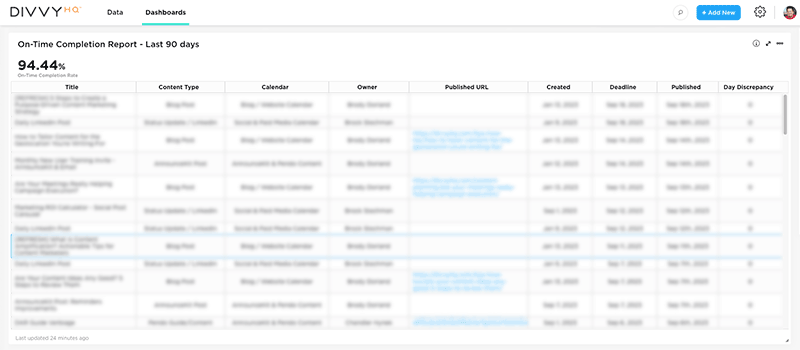Content marketers are often creative, passionate wordsmiths who live and breathe storytelling. Because they tend to have a perfectionist streak, it can be a struggle when placed in a managerial role and someone on the team is not giving it their all. When a team member is underperforming, what can we do?
Organizationally, poor performance is an early sign of talent disengagement and future attrition; hence a risk to overall productivity. Managers need to identify and deal with poor performance early on.
In most cases, underperformance may not be intentional and is a result of an employee dealing with personal issues. Supporting them on a human level is equally, if not more, important. Yet, managers may find it challenging and uncomfortable to deal with underperforming employees.
In this article, we will discuss the early signs of poor performance, possible causes, and how you can work with your team members to help them get back on track.
Recognize the Early Signs of Poor Performance
When employees struggle to deliver their job responsibilities, they are performing poorly. But what do the early signs of poor performance look like in practice?
Imagine you tasked your team member with purchasing a web domain for the launch of a new product microsite. Their next step is to reach out to Only Domains, find out the terms, involve procurement, and plan website design with the Digital team. You realize on a project update call that none of this has been done. Is it a one-off omission by the employee or a sign of a bigger problem?
The key is to be observant. An employee may fail to reach their goals or meet project deadlines. They may be consistently late for work, have low attendance, forget important tasks, and have a negative attitude — complain, or even cause conflict with their coworkers or managers.
Other early signs of poor performance include:
- A lack of caring for work quality and poor attention to detail
- Failing to accomplish tasks and get things done
- Not taking feedback
- Repeating the same mistakes despite earlier input from the team or management.
Measure Poor Performance
Poor performance is rarely an instant occurrence. Its signs usually manifest over time. As a manager, once you notice an employee’s poor performance, how do you measure and quantify it?
Managers have several formal tools to gather facts and evidence related to poor performance. There is 360-degree feedback which can provide anecdotal data from HR, which can reveal patterns in absence and sickness. The right tools for the job are critical.
It’s also important to keep the communications channels open, whether in person or with enterprise video conferencing solutions. Upgrading the conferencing solution might help resolve some team communication issues.
At this fact-gathering stage, the manager would review the data and reflect on the following questions:
- Has the employee’s performance been deteriorating gradually?
- Or was there a specific moment in time when it dropped suddenly?
- Has their performance been poor overall, or on a specific task or project only?
- Has the employee’s job description changed significantly lately?
- Have there been a series of conflicts with their coworkers or leadership?
- Have they responded positively to feedback, making the requested changes?
For content managers using DivvyHQ, Divvy’s analytics module provides standard reports to monitor on-time completion of tasks and content projects. These reports can be very helpful in identifying producers who are consistently late with project delivery.
Divvy Analytics – On-Time Completion Report
Sharing data with the affected employee is a good way to be transparent with them. Using collaborative feedback tools like Markup could help in the process.
Identify Poor Performance Causes
What could be the cause of your team member’s poor performance? Why are they struggling to deliver on their goals and objectives?
Let’s say a content producer received a clear brief for a B2B article about Android VNC server, a remote access software solution. When the deadline came, their content manager did not receive the article. What went wrong?
These are some of the factors the manager needs to consider:
- Is the employee clear on their goals and objectives?
- Does the employee lack the skills or domain knowledge to deliver on their job responsibilities?
- Do they lack the resources or support to perform their role?
- Are there any issues with communication or silos in the content team processes?
- Is the employee experiencing burnout or other well-being issues?
- Are they struggling with their personal life, e.g., health or caring responsibilities?
- Lastly, but most importantly, could your leadership be causing problems?
Having a Difficult Conversation
You’ve gathered your facts, identified the patterns and possible causes, and now have a full picture of what may be going on. Addressing poor performance head-on is essential. The next step is to meet with the employee and have an open, constructive discussion about their performance.
We are all human, so it is natural to try and avoid such conversations. The employee may get emotional. It may be hard for you to stay calm. Yet, it is essential that the review meeting takes place as soon as possible.
As a manager, your goal for this meeting is to review and understand the cause of poor performance, how to support your team member, and formulate a clear and achievable action plan. You need to practice non-violent communication and conflict resolution skills, have an open mind, and stick to the facts rather than letting emotions take over.
Ideally, the meeting should be held in person. However, in the modern connected world, you might need to use conference call software. In this case, make sure you carefully observe the employee for non-verbal cues. Follow these steps for the performance review meeting:
- Schedule the meeting in a private location.
- Get straight to the point.
- Be polite and respectful. Actively listen to your employee.
- Compare their performance against their job responsibilities and goals.
- Be specific, use data and facts, and provide clear examples.
- Steer the conversation towards solutions.
- Discuss performance improvement plans with realistic objectives and metrics.
- Agree on how you will track performance.
- Ask what support the employee needs from you and the organization to perform.
- Set a reassessment time frame.
As a manager, you need to prepare for an emotional response from your employee. If emotions run high, you can take a break and return to the meeting later. But always return to the discussion, take your time with it, even if it’s difficult.
Coaching the employee is an effective strategy — ask many questions to dig deep into the causes of their poor performance and help them figure out what’s going on. Help them ensure they use the right tools to be productive and get organized. The best managers coach employees to figure out a solution together.
If the employee has all the skills and support they need, and there appear to be no causes for their poor performance, you will need to pursue the formal performance management route. Involve HR early to make sure you follow the right policies and processes, record and document every interaction, and capture and track relevant data.
Create the Performance Improvement Plan
A performance improvement plan is a plan of action that is mutually agreed upon in a performance review meeting. At a high level, it should set out expectations and goals for the employee and outline ways to achieve them within a specified timeframe. It should also include details regarding managerial support, performance metrics, and a timeframe for the next review.
Your approach for managing poor performance will depend on the root cause. Let’s say you ask a team member to create an email newsletter explaining how to use a visual voicemail service. They fail for some reason, the newsletter is not sent out on time, and senior management is asking you what happened.
If you find out that your employee is struggling due to ill health, your action plan will be based on that. If, however, you discover that they are not coping with their workload, your plan of action for them will be very different.
Below we list strategies you could consider to help you shape the performance improvement plan.
- Review the overall job description: Is the employee overworked and burnt out? Do they have the right skills for the job, or do they need training? Consider reducing their workload, offering training, or mentoring. Or, if they are a better fit elsewhere within the organization, consider helping them move into a different role.
- Set clear goals and expectations: Make sure the employee understands what they need to improve and how. Put it in writing and offer regular constructive feedback and coaching to ensure they stay on track.
- Review the tools and resources: Does your team have the right tools and resources for the job? Often not having the appropriate tools or resources creates unnecessary stress and overwork. Review your team’s tasks, processes, and tools. Use this guide to streamline content marketing workflows for ideas.
- Decide on clear actions: Do not expect the employee to figure out how to improve their performance. Suggest ways to do so and be proactive about creating an action plan with clear next steps and deliverables your employee can follow.
- Evaluate your management style: Are there ways to support the affected employee better? Do you provide regular, clear, and constructive feedback to your team members? Are you known to communicate well? Use this as an opportunity to get feedback and mentoring for yourself so that you can grow as a manager.
Follow up Effectively
With the performance improvement plan in place, the next important step is follow-up. It includes regular feedback, performance KPI monitoring, progress evaluation, and ultimately the decision on the next steps.
Hopefully, your plan is effective, and your employee is successful. In this case, you will have learned through this experience and become a better manager. Managing poor performance is an essential management skill to learn. And there is no better feeling than helping a team member get back on track and succeed.
For more great tips, tricks, and how-to’s, subscribe to the DivvyHQ blog today!




